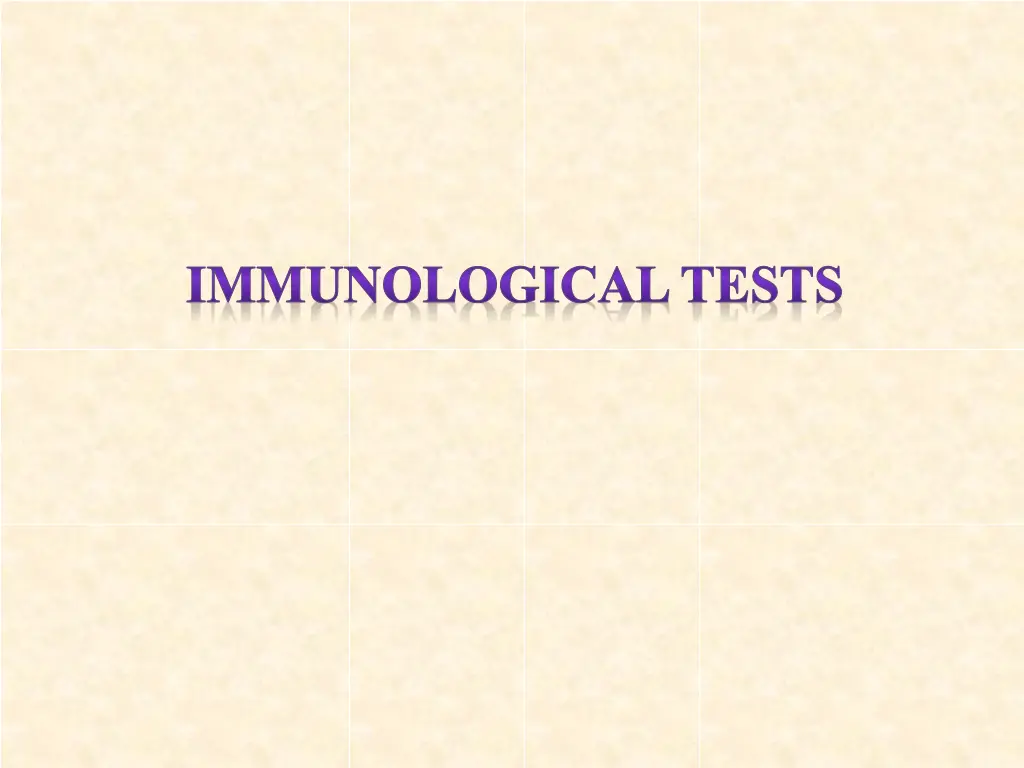
Understanding Immunological Tests and Reactions in Disease Diagnosis
Explore the principles, aims, and types of immunological tests in diagnosing diseases, monitoring disease progression, and determining prognosis. Learn about precipitation and agglutination reactions, along with double and single immune diffusion methods.
Download Presentation

Please find below an Image/Link to download the presentation.
The content on the website is provided AS IS for your information and personal use only. It may not be sold, licensed, or shared on other websites without obtaining consent from the author. If you encounter any issues during the download, it is possible that the publisher has removed the file from their server.
You are allowed to download the files provided on this website for personal or commercial use, subject to the condition that they are used lawfully. All files are the property of their respective owners.
The content on the website is provided AS IS for your information and personal use only. It may not be sold, licensed, or shared on other websites without obtaining consent from the author.
E N D
Presentation Transcript
Aims of immunological tests: 1. Diagnosis of diseases. 2.Follow-up the progress of diseases. 3.Determination the prognosis of some diseases.
Principle of any immunological test: 1)(Fab) region of antibody binds single epitope of an anus /immune complex) 2)Binding Fab region antibody to another epitope of same antigen (cross linking)
Types of immunological reaction 1)Precipitation reaction. 2)Agglutination reaction. 3)Immunoassay using conjugate (Fluorescence. Enzyme. Radioactive material Chromogen).
Precipitation reaction * BothAg andAb are soluble. * Using semisolid agar (agarose). * Ags are in patient serum It s of two types: 1. Double immune diffusion (Ouchterlony). 2. Single radial immune diffusion. Both single & double immune diffusion test: use petridish& agarose media
But the difference: In single. Abs mix with agarose. In double, Abs is placed in well. Single radial immune diffusion (SKID) > Abs mix with agarose (gel). > Ags in the well only diffuse radially (in all directions) > Forming ring of precipitation. > Measurement the diameter of the outer ring & compare it > With standard curve. > Clinical application (Uses): Quantitation of serum proteins (Ex. IgG, IgM, IgA, C3 & C4)
Double immune diffusion: Both Ag and Ab diffuse in the media 1) Identify:The zone of precipitation is continuous which occur when there is the same Ags or one infection in the patient 2) Non-identify: occur when there is more than one Ag epitope or infection 3) Partial identify: occur when there is partial similarity between Ags. This occurs in microbes that have more than 1 serotypes like Salmonella, Streptococcus.
Agglutination reaction * Abs soluble and Ags are in soluble. * Using particles (bacteria, REC, Latex) for attachment of Ags with it. * Abs in the serum of patients. * Agglutination will be formed as lattice.
Direct agglutination Bacterial agglutination (Widal test for typhoid fever) (Tube method) Ab = present in patient serum Ag = Naturally present on the surface of Salmonella spp. O (somatic Ag. Salmonella) & H (Flagellar Ag. Salmonella) Anti O titer (> 1:160) = Active infection Anti H titer (> 1:160) = Past infection or Past immunization
Passive (Indirect) agglutination (Latex Test) * Using latex particles Coated with Ags. * Detection Rheumatoid factor &. C-Reactive protein (both have same principle} * Ag (IgG coated latex particle}. * Ab: a) in Rheumatoid factor test (IgM in patient s serum). b) In C - reactive protein test (C - reactive protein in patient serum






















